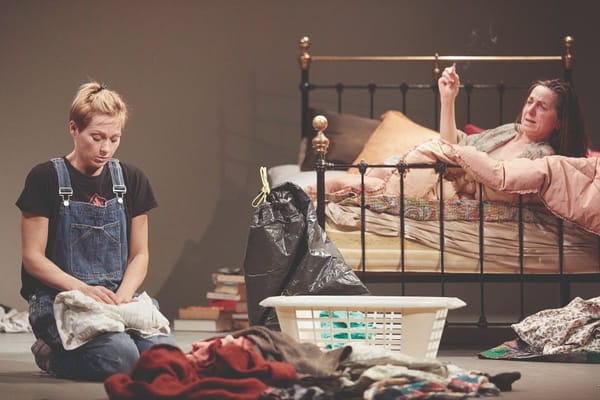Bottom: A queer bildungsroman
Written and performed by Willy Hudson, his one-man show Bottom shares funny, awkward and entertaining experiences.

Bottom. A term used to describe a person in a gay relationship who prefers to be the one penetrated. However, this simple expression of which sexual position one prefers has many other deep rooted connotations and assumptions within queer culture. And it is these themes which Willy Hudson brilliantly addresses in his one man show Bottom.
Performed in a small room at Pleasance Theatre, and also at Edinburgh Fringe, the intimate setting allowed Hudson to connect with the audience more easily and involve them as part of his show. He begins the show immediately breaking the fourth wall, by popping his head out of the curtain and stopping the music as he says he’s not ready yet. He shuffles onto the stage through a side door wearing nothing but a neon pink towel wrapped around his waist and dragging in a big pink bag with his props. Joining his simple set of the lower half of a mannequin wearing boxers on one side, and a microphone stand on the other side, the focus is on the partially nude man standing in front of you.
He proceeds to ask an audience member to pass him his underwear from under their seat, and gets two other people to hold his towel tightly as he starts getting dressed. We wait as we watch him get fully clothed, making little jokes about the pattern on his socks, until he proudly dons a t-shirt with a head-to-toe picture of Beyoncé printed on it. Within these first few minutes, the general theme and nature of the play has been defined as a comedic display of queer culture.
Hudson begins to talk about his recent sexual encounter where he runs into the bathroom as he feels very embarrassed that he is unable to become erect. Using perfectly timed tech cues to play the sound of a door locking and turning on the tap as he made the action, the audience was transported into the scene as panic rises over the character about why he is unable to get stimulated. The lights change and Hudson moves from centre stage to stage left where he begins to speak into the microphone about erectile dysfunction disorder. This change in tone where he speaks about a topic from his life or queer culture is a theme which carries on through the play and allows Hudson to have more flexibility about the range of topics he can touch upon.
The play continues to describe Hudson’s story of meeting up with a guy on the gay dating app Grindr, and explaining how the date had gone terribly wrong, especially as he, who has only bottomed in the past, now fails to get an erection in the one situation where he tries to top. Whilst this may seem like a raunchy tale of sexual crisis and trivial matters of preferred sexual position, Hudson was able to hit many key notes about the LGBT+ experience and queer culture.
Throughout the play he touches upon topics such as how straight women sometimes use gay men as toys for their own entertainment (referred to as fag hags), the concept that tops or bottoms can be predicted based upon their external appearance and attitude, and the internalised homophobia within the queer community when it comes to giving more respect to ‘straight acting’ butch gay men. I feel that in some respects viewers who are not part of or closely related to the LGBT+ community may not understand the full depth of the topics being discussed. Particularly focussing on the core theme of the play which is bottoming and sexual positions, Hudson is somehow able to address the issue with an air of humour yet seriousness at the same time. He speaks on the obsession of describing one’s sexual position preference on dating apps, degrading other men to just their holes, and how the imminent question of ‘top or bottom?’ will always appear early on when speaking to someone on these apps. But Hudson doesn’t hesitate to dig even deeper and exposes the internalised homophobia that many gay men have in idolising the butch men who can give them the shred of fantasy of being in a ‘normal’ heterosexual relationship, and subsequently degrading other men for being too femme.
The play was extremely enjoyable and truly a pleasure to watch. The themes explored and the humour, integrated with consistent and high quality audience participation, made the experience much better than anything I would have expected.
My only qualm was that at points the flow of the otherwise amazing play was interrupted and may have caused some confusion. I was unsure whether Hudson purposely broke character as part of the play or if it was by accident. At certain points, the lights changed and lit up a different part of the stage, and Hudson made an audible realisation that he was supposed to move on, but this didn’t register as smoothly as it could have done. However, I do commend the use of breaking the fourth wall.
During one scene the character is attempting to demonstrate his desire for being a top on the mannequin on the stage but is unable to do so. Hudson breaks character and asks the tech director for what he was supposed to do and she replies from the back of the room asking whether he would like to try again, to which he eventually asks to move on. This seemed very real in the moment and added a new layer to the play.
Overall, this was one of the best fringe plays I have seen, and was very well suited to the small size of the theatre. It was honestly a pleasure to watch!
4.5 stars








